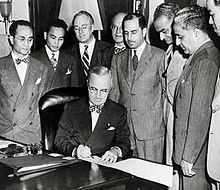Luce–Celler Act of 1946

President Truman signs the bill
The Luce–Celler Act of 1946 was proposed by Republican Clare Boothe Luce and Democrat Emanuel Celler in 1943 and signed into law by President Harry Truman on July 2, 1946.
Effects of the law
The act provided a quota of 100 Filipinos,[1] and 100 Indians to immigrate into the United States per year.[2] As the Philippines became independent from the United States in 1946, Filipinos would have been barred from immigrating without the act.[3]
The act also allowed Filipino Americans and Indian Americans to naturalize and become United States citizens.[4] Upon becoming citizens, these new Americans could own homes and farmland, and petition for family from their nation of birth.[5]
See also
- History of Asian-American immigration
References
- ↑ Bayor, Ronald (2011). Multicultural America: An Encyclopedia of the Newest Americans. ABC-CLIO. p. 714. ISBN 978-0-313-35786-2. Retrieved 7 February 2011.
- ↑ Bayor, Ronald (2011). Multicultural America: An Encyclopedia of the Newest Americans. ABC-CLIO. p. 969. ISBN 978-0-313-35786-2. Retrieved 7 February 2011.
- ↑ Trinh Võ, Linda (2004). Mobilizing an Asian American community. Philadelphia: Temple University Press. p. 288. ISBN 978-1-59213-262-1. Retrieved 7 February 2012.
The Philippines was granted independence in 1946, and Filipinos, then barred from immigration along with individuals from other countries in the "Eastern Hemisphere," were allotted 100 immigration slots (Yu 1980).
- ↑ Okihiro, Gary Y. (2005). The Columbia Guide to Asian American History. New York: Columbia University Press. p. 24. ISBN 978-0-231-11511-7. Retrieved 7 February 2011.
- ↑ Mabalon, Dawn B.; Rico Reyes, Filipino American National Historical Society, Little Manila Foundation (2008). Filipinos in Stockton. Arcadia Publishing. p. 8. ISBN 978-0-7385-5624-6. Retrieved 7 February 2012.